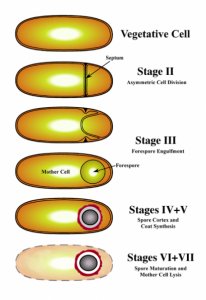
Which Bacteria have Capsule?
 Microorganisms sense and adapt to changes in their environment. When favored nutrients are exhausted, some bacteria may become motile to seek out nutrients, or they may produce enzymes to exploit alternative resources. One example of an extreme survival strategy employed by certain low G+C Gram-positive bacteria is the formation of endospores. This complex developmental process is often initiated in response to nutrient deprivation. It allows the bacterium to produce a dormant and highly resistant cell to preserve the cell's genetic material in times of extreme stress.
Microorganisms sense and adapt to changes in their environment. When favored nutrients are exhausted, some bacteria may become motile to seek out nutrients, or they may produce enzymes to exploit alternative resources. One example of an extreme survival strategy employed by certain low G+C Gram-positive bacteria is the formation of endospores. This complex developmental process is often initiated in response to nutrient deprivation. It allows the bacterium to produce a dormant and highly resistant cell to preserve the cell's genetic material in times of extreme stress.
Endospores can survive environmental assaults that would normally kill the bacterium. These stresses include high temperature, high UV irradiation, desiccation, chemical damage and enzymatic destruction. The extraordinary resistance properties of endospores make them of particular importance because they are not readily killed by many antimicrobial treatments. A variety of different microorganisms form "spores" or "cysts", but the endospores of low G+C Gram-positive bacteria are by far the most resistant to harsh conditions.
Endospore Structure
The resilience of an endospore can be explained in part by its unique cellular structure. The outer proteinaceous coat surrounding the spore provides much of the chemical and enzymatic resistance. Beneath the coat resides a very thick layer of specialized peptidoglycan called the cortex. Proper cortex formation is needed for dehydration of the spore core, which aids in resistance to high temperature. A germ cell wall resides under the cortex. This layer of peptidoglycan will become the cell wall of the bacterium after the endospore germinates. The inner membrane, under the germ cell wall, is a major permeability barrier against several potentially damaging chemicals. The center of the endospore, the core, exists in a very dehydrated state and houses the cell's DNA, ribosomes and large amounts of dipicolinic acid. This endospore-specific chemical can comprise up to 10% of the spore's dry weight and appears to play a role in maintaining spore dormancy. Small acid-soluble proteins (SASPs) are also only found in endospores. These proteins tightly bind and condense the DNA, and are in part responsible for resistance to UV light and DNA-damaging chemicals. Other species-specific structures and chemicals associated with endospores include stalks, toxin crystals, or an additional outer glycoprotein layer called the exosporium.
 Endospore Development
Endospore Development
The process of forming an endospore is complex. The model organism used to study endospore formation is Bacillus subtilis. Endospore development requires several hours to complete. Key morphological changes in the process have been used as markers to define stages of development. As a cell begins the process of forming an endospore, it divides asymmetrically (Stage II). This results in the creation of two compartments, the larger mother cell and the smaller forespore. These two cells have different developmental fates. Intercellular communication systems coordinate cell-specific gene expression through the sequential activation of specialized sigma factors in each of the cells. Next (Stage III), the peptidoglycan in the septum is degraded and the forespore is engulfed by the mother cell, forming a cell within a cell. The activities of the mother cell and forespore lead to the synthesis of the endospore-specific compounds, formation of the cortex and deposition of the coat (Stages IV+V). This is followed by the final dehydration and maturation of the endospore (Stages VI+VII). Finally, the mother cell is destroyed in a programmed cell death, and the endospore is released into the environment. The endospore will remain dormant until it senses the return of more favorable conditions. [A sigma factor is a small protein that directs RNA polymerase to specific cites on DNA to initiate gene expression.]
Endospores and Epulopiscium
Some Epulopiscium-like surgeonfish symbionts form mature endospores at night. These spores possess all of the characteristic protective layers seen in B. subtilis endospores and also contain large amounts of dipicolinic acid. These are the largest endospores described thus far, with the largest being over 4000 times larger than a Bacillus subtilis endospore.
The formation of endospores may help maintain the symbiotic association between these Epulopiscium-like symbionts and their surgeonfish hosts. Since endospore formation coincides with periods in which the host surgeonfish is not actively feeding, the cells do not need to compete for the limited nutrients present in the gut at night. The protective properties of the endospores also allow them to survive passage to new surgeonfish hosts. The fish may also benefit from this relationship because it is able to maintain stable microbial populations that assist in digestion and may receive a nutritional gain from microbial products released during mother cell death and spore germination.
Daily life cycle of endospore-forming Epulopiscium-like symbionts.Endospore formation in some Epulopiscium-like symbionts follows a daily cycle:
A) Polar septa are formed at the poles of the cell.
) Forespores become engulfed.
C) Forespores gradually increase in size within the mother cell through the day.
) In late afternoon, final preparations for endospore dormancy.
E) Endospores mature and remain dormant throughout most of the night.
F) Just before sunrise, the endospores germinate and are released from mother cell to repeat the cycle.



